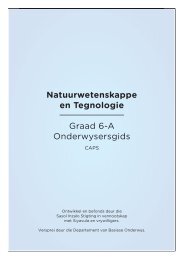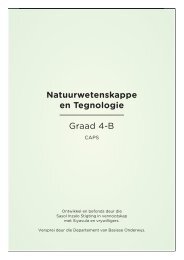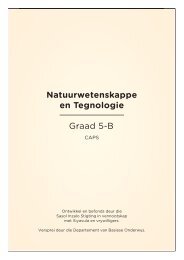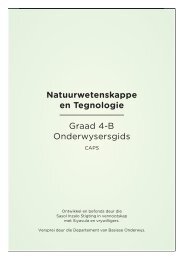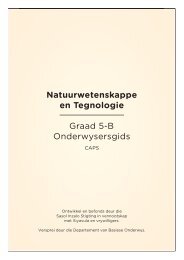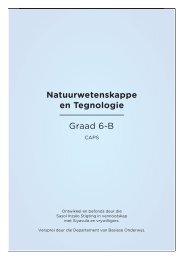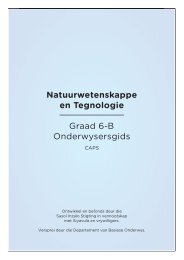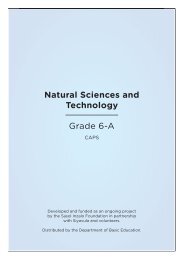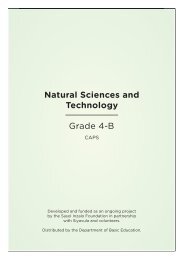- Page 1 and 2:
Natural Sciences and Technology Gra
- Page 3 and 4:
AUTHORS LIST This book was written
- Page 5 and 6:
THE NATURAL SCIENCES AND TECHNOLOGY
- Page 7:
Matter and Materials and Structures
- Page 12 and 13:
1 Stored energy in fuels 4 KEY QUES
- Page 14 and 15:
VISIT How fossil fuels are made. go
- Page 16 and 17:
So we can say that food is the fuel
- Page 18 and 19:
MATERIALS: • various packaging fo
- Page 20 and 21:
Coal is not only burnt in our homes
- Page 22 and 23:
2. Remove both ends of the large ca
- Page 24 and 25:
QUESTIONS: 1. Which fuel contained
- Page 26 and 27:
INVESTIGATION: What happens when af
- Page 28 and 29:
VISIT Burning substances in air and
- Page 30 and 31:
3. Write a description next to each
- Page 32 and 33:
3. What causes of fire can you iden
- Page 34 and 35:
3. Some points to think about when
- Page 36 and 37:
1. Describe the relationship betwee
- Page 38 and 39:
2 Energy and electricity 30 KEY QUE
- Page 40 and 41:
When the electrical energy is trans
- Page 42 and 43:
A car needs energy to start its eng
- Page 44 and 45:
Huge pylons carrying the transmissi
- Page 46 and 47:
ACTIVITY: 10 Safety tips for electr
- Page 48 and 49:
KEY CONCEPTS Never stick a metal kn
- Page 50 and 51:
3 Energy and movement 42 KEY QUESTI
- Page 52 and 53:
2. Tie another elastic band around
- Page 54 and 55:
QUESTIONS Look up adefinition for p
- Page 56 and 57:
5. Place it in the water, and let i
- Page 58 and 59:
QUESTIONS Use your knowledge of spr
- Page 60 and 61:
4 Systems for moving things 52 KEY
- Page 62 and 63:
Teacher's Note You can demonstrate
- Page 64 and 65:
QUESTIONS Label the two wheels and
- Page 66 and 67:
4. Place a few marbles or some othe
- Page 68 and 69:
6. Repeat this for the other 2wheel
- Page 70 and 71:
The board makes bearings for the ax
- Page 72 and 73:
INSTRUCTIONS: Things you can use fo
- Page 74 and 75:
REVISION: 1. List four dierent vehi
- Page 78 and 79:
1 Planet Earth 70 KEY QUESTIONS •
- Page 80 and 81:
• The Earth spins right around in
- Page 82 and 83:
3. Was it daytime in Saudi Arabia?
- Page 84 and 85:
VISIT Short video showing the sun,
- Page 86 and 87:
The planets move in orbits around t
- Page 88 and 89:
MATERIALS: • 100m heavy string
- Page 90 and 91:
Teacher's Note Make sure to point o
- Page 92 and 93:
2 Surface of the Earth 84 KEY QUEST
- Page 94 and 95:
QUESTIONS: 1. What is under the flo
- Page 96 and 97:
Imagine we could cut aslice out of
- Page 98 and 99:
QUESTIONS 1. If you dig ahole in th
- Page 100 and 101:
Teacher's Note Iron melts at those
- Page 102 and 103:
The hole will come to of the other
- Page 104 and 105:
Look at the place where the water h
- Page 106 and 107:
VISIT Rocks erode to form soil (vid
- Page 108 and 109: ACTIVITY: Make a model of acid wate
- Page 110 and 111: ACTIVITY: Look at dierent kinds of
- Page 112 and 113: MATERIALS: • 3 big cool drink bot
- Page 114 and 115: In the beginning, you might think t
- Page 116 and 117: The topsoil has gone from this land
- Page 118 and 119: INSTRUCTIONS: 1. Collect two tins o
- Page 120 and 121: QUESTIONS 1. Can you make pots with
- Page 122 and 123: VISIT Interesting website about soi
- Page 124 and 125: QUESTIONS: 1. Are the drops on the
- Page 126 and 127: Set up the soils as you see in the
- Page 128 and 129: Which soil type do plants grow best
- Page 130 and 131: Average height grown by seedlings i
- Page 132 and 133: Answer: Crust, mantle, core. 2. Wha
- Page 134 and 135: 3 Sedimentary rocks VISIT Dierent r
- Page 136 and 137: Sediments When the sand grains coll
- Page 138 and 139: 2. Which is the oldest sediment? Th
- Page 140 and 141: Look at the layers in the sedimenta
- Page 142 and 143: This is how the mountains look now.
- Page 144 and 145: A sculpture made from limestone. 10
- Page 146 and 147: Cement is also made from shale. The
- Page 148 and 149: 4 Fossils 140 KEY QUESTIONS • Wha
- Page 150 and 151: VISIT When a T-Rex attacks! (video)
- Page 152 and 153: VISIT How are fossils formed? goo.g
- Page 154 and 155: Teacher's Note Of course, it's much
- Page 156 and 157: Teacher's Note Note that the mould
- Page 160 and 161: A footprint which has hardened in t
- Page 162 and 163: Do you know where this is in South
- Page 164 and 165: VISIT Finding the coelacanth (video
- Page 166 and 167: I just love learning more and more
- Page 168 and 169: ACTIVITY: Thinking about the Cradle
- Page 170 and 171: REVISION: 1. Are animal fossils mad
- Page 172 and 173: 5 Notes 164 Chapter 1 Stored energy



